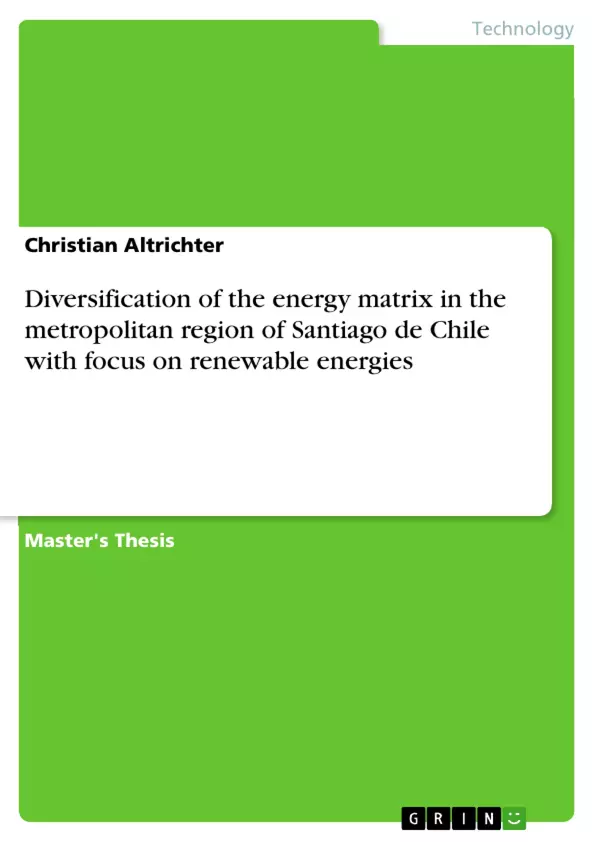Abstract:
This work aims to provide a solution for the diversification of the Chilean energy matrix with a focus on renewable energies. The research is embedded in the project called Risk Habitat Megacity, which investigates the development of urban settlements in the context of their sustainability. The first part explains the importance of cities and their link as energy consumption centers in the Chilean context. A historical analysis of the energy situation describes the three energy crisis the country has suffered from and how to overcome the energy shortages. Chile has recently changed its policy framework in favor of Renewable Energies. The electricity sector is a vital element of the analysis, as only a well-designed and competitive market allows the integration of renewable energies. The fourth chapter discusses measurements and shows a path into a more sustainable development, with enhanced energy security, a lower import dependency, but with the necessity for the Chilean government to develop a comprehensive long-term energy policy framework, that includes energy policy and energy efficiency programs alike. This investigation is an initial attempt.
keywords: energy matrix, energy crisis, electricity sector, energy efficiency, energy security
Resumen:
Este proyecto tiene como objetivo proveer una solución para la matriz energética de Chile enfocando en las energías renovables. La investigación forma parte del proyecto "Risk Habitat Megacity", que investiga el desarrollo de asentamientos urbanos en el contexto de la sustentabilidad. La primera parte explica la importancia de las ciudades y su conexión como centros de consumo energético en Chile. Un análisis histórico de la situación energética analiza las crisis energéticas que sufrió el país y cómo afrontar las escasez de energía. Chile ha cambiado recientemente su marco político a favor de las energías renovables. El sector de energía eléctrica es un elemento vital del análisis, ya que sólo un mercado bien diseñado y competitivo permite la integración de las energías renovables. Las mediciones discutidas en el capítulo cuatro muestran un camino hacia un desarrollo sostenible, mejorando la seguridad energética, dependiendo en menor medida de la importación, pero con la necesidad de que el gobierno chileno desarrolle un marco político-energético, que incluya políticas energéticas como los programas para la eficiencia energética. Esta investigación brinda una contribución inicial.
Inhaltsverzeichnis (Table of Contents)
- Introduction
- Cities & their relation to energy
- Historical Context
- The development of Santiago in the context of Latin American cities
- Project Context
- Urbanization & Energy
- Energy Situation
- Introduction and development of energy matrix
- Concepts of Energy Security
- The electricity sector
- The electricity grid in Chile
- The reform process until 2000
- Post-Privatization period and the electricity market structure
- Framework for Renewable Energy Integration
- Technology Approach - Smart Grids
- Approaches to Electricity Security and Recommendations
- Diversification Options
- Demand Side Options
- Energy Efficiency
- Transport Sector
- Commercial, public and residential sector
- Industry Sector
- Regulatory measures
- Supply Side Options
- Renewable Energies
- Renewable Energies in the Chilean context
- Hydropower
- Geothermal Energy
- Wind Power
- Biomass & Biofuels
- Ocean Energy
- Solar Energy
- Indigenous Resources
- Nuclear Power
- Demand Side Options
Zielsetzung und Themenschwerpunkte (Objectives and Key Themes)
This work aims to provide a solution for the diversification of the Chilean energy matrix with a focus on renewable energies. The research is embedded in the project called Risk Habitat Megacity, which investigates the development of urban settlements in the context of their sustainability.- The importance of cities as energy consumption centers in the Chilean context
- Historical analysis of the Chilean energy situation and the three energy crises the country has suffered from
- The role of the electricity sector in facilitating the integration of renewable energies
- Measures and strategies for a sustainable development with enhanced energy security and reduced import dependency
- The need for a comprehensive long-term energy policy framework that includes both energy policy and energy efficiency programs
Zusammenfassung der Kapitel (Chapter Summaries)
The first chapter explores the importance of cities and their role as energy consumption centers in the Chilean context. It provides a historical analysis of the energy situation in Chile, including descriptions of the three energy crises the country has faced and the strategies used to overcome energy shortages. The second chapter focuses on the development of the Chilean energy matrix and the concept of energy security. It examines the importance of a well-designed and competitive electricity market in facilitating the integration of renewable energies. The third chapter delves into the electricity sector in Chile, including the electricity grid, the reform process until 2000, and the post-privatization period. It analyzes the current electricity market structure and discusses the framework for renewable energy integration, including the technology of smart grids. The fourth chapter presents various diversification options, focusing on both demand-side and supply-side measures. It discusses energy efficiency programs, the transport sector, commercial and residential energy consumption, and regulatory measures. The chapter also explores the potential of renewable energy sources in the Chilean context, including hydropower, geothermal energy, wind power, biomass, and solar energy.Schlüsselwörter (Keywords)
This work focuses on the diversification of the Chilean energy matrix, emphasizing renewable energies within the broader context of sustainable urban development. Key topics include energy security, energy efficiency, electricity sector, energy crisis, and renewable energy technologies.- Quote paper
- Diplom Volkswirt Christian Altrichter (Author), 2011, Diversification of the energy matrix in the metropolitan region of Santiago de Chile with focus on renewable energies, Munich, GRIN Verlag, https://www.grin.com/document/178706



